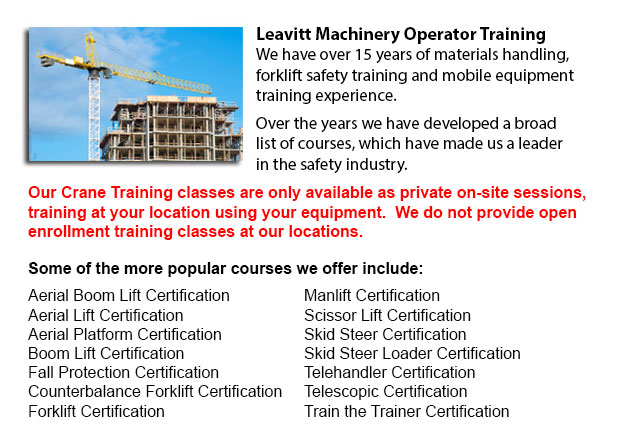
Guelph Crane Certification - The Crane Certification training program covers content recommended by industry concerning the safe and efficient operation of cranes. Trainees would know the following: how to identify cranes and their component parts; pre-operational, operational and post-operating requirements; rigging components and inspection/rejection criteria; how to determine overall lift capacity; and requirements specific to the work location where the trainees would be operating.
Pre-operational requirements consist of assigning authority for the pre-operational check; performing the sequential pre-operational check based on the manufacturer's specifications or specifications certified by a professional engineer; inspecting the work area for obstacles and hazards; checking the log book for comments; checking cables, hooks, chains safety latches and crane movement; ensuring the proper functioning of operational controls; and learning how to make sure that the crane's disconnect switch/isolator is working right.
Operational requirements include identifying roles and responsibilities, and determining the requirement for a formal lift plan. People training will be taught how to carry out a hazard assessment connected to environmental circumstances, physical conditions and workers. Subject matter consists of determining when to seek competent help, the safest route and destination of loads, and load weight and centre of gravity.
Individuals training must be able to identify an over-capacity lift, in addition to be able to pick appropriate rigging machine, choose load limitations, and to determine the safe site for the crane to work from. Trainees will review both universal and site-specific crane signals for lifts, and methods for lifting, loading and traveling. Correct maintenance practice will be included.
The person training will undergo an examination to test their understanding of emergency response procedures for various conditions, specially electrical or mechanical failures. They would be asked to describe shut down and parking procedures for safety and security, to follow tagging and lock out procedures, and to explain why near misses are reported and recorded to the appropriate individual. Log book records must be maintained.
Trainees will develop knowledge of rigging, in particular, establishing who has responsibility and authority for rigging, identifying various types of rigging, knowing load capacity ratings and storage procedures.
The requirements following operation of the crane will be taught as well, learning to enter the defects and deficiencies; and to log the history of maintenance and service records, in accordance to the federal, state and provincial codes requirements.
Site-specific requirements could be included into the safety training program according to the employer's requirements.
-
Guelph Warehouse Forklift Training Classes
Guelph Warehouse Forklift Training Classes - Warehouse training classes exist for the reason of raising awareness regarding common warehouse hazards. Students learn the important safety procedures that are necessary to warehouse safety. An emphasis i... More -
Guelph Forklift Operator Certification
Guelph Forklift Operator Certification - Certification for forklifts are needed to guarantee the safe use of forklifts for those employers in construction, industrial and warehouse settings. The training has to involve a method of education plus some... More -
Guelph Crane Training School
Guelph Crane Training School - The crane training school offers industry-relevant programs. Courses provide trainees with learning results that match current industry demands. Our small class sizes combine hands-on experience and theory. Our qualifie... More -
Guelph Heavy Equipment Training Programs
Guelph Heavy Equipment Training Programs - At whatever given construction site, there are usually various kinds of machines that are ready to be used. These heavy and light equipment need both operators to run them and mechanics to fix them. Apprenti... More -
Guelph Skid Steer Ticket
Guelph Skid Steer Ticket - On a skid-steer loader, the lift arms are at the side of the driver together with pivot points at the back of the driver's shoulders. This makes them different compared to a traditional front loader. Because of the operator... More -
Guelph Zoom Boom Ticket
Guelph Zoom Boom Ticket - Zoom Boom Training focuses on correctly training prospective operators on variable reach forklifts. The training goals include gaining the understanding of the equipments physics and to define the tasks of the operator. This... More -
Guelph Heavy Equipment Training
Guelph Heavy Equipment Training - Commonly, the different types of heavy equipment training are divided into 2 categories of machinery: those that have rubber tires and tracked vehicles. Tracked vehicles consist of items like for instance bulldozers,... More -
Guelph Aerial Lift Safety Training
Guelph Aerial Lift Safety Training - Each year, there are roughly 26 construction deaths due to the use of aerial lifts. Nearly all of the craftsmen killed are laborers, electrical workers, carpenters, painters or ironworkers. Nearly all deaths are c... More

Forklift Certification Guelph
TOLL FREE: 1-888-254-6157
Guelph, Ontario
forkliftcertificationguelph.com
Email Us
About Us


